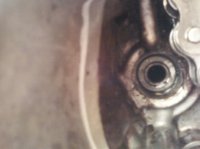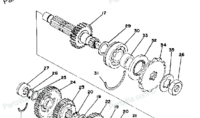1978 2e SOHC
I've had an oil leak on the left side of the engine behind the sprocket cover for a while now which stops when the bike is not running. I replaced the gasket on the stator cover and sealed it with Threebond, but it didn't help. SO, I am pretty sure it is the push-rod oil seal.
I replaced the seal previously with some no name brand oil seal from Ebay. The packaging literally said "xs400" and nothing else. I'm assuming it wasn't the highest quality seal available and who knows how old it was.
Anyway, I pulled out the leaking seal and took a photo. I just want to be absolutely sure what I am seeing is not the metal backing plate from the OEM seal. The replacement seal sat flush with the engine and didn't stick out at all, but there is a metal ring in there with 4 grooves which are 90 degrees apart.
I have an OEM Yamaha seal waiting to go in. I am just looking for confirmation.
I've had an oil leak on the left side of the engine behind the sprocket cover for a while now which stops when the bike is not running. I replaced the gasket on the stator cover and sealed it with Threebond, but it didn't help. SO, I am pretty sure it is the push-rod oil seal.
I replaced the seal previously with some no name brand oil seal from Ebay. The packaging literally said "xs400" and nothing else. I'm assuming it wasn't the highest quality seal available and who knows how old it was.
Anyway, I pulled out the leaking seal and took a photo. I just want to be absolutely sure what I am seeing is not the metal backing plate from the OEM seal. The replacement seal sat flush with the engine and didn't stick out at all, but there is a metal ring in there with 4 grooves which are 90 degrees apart.
I have an OEM Yamaha seal waiting to go in. I am just looking for confirmation.


